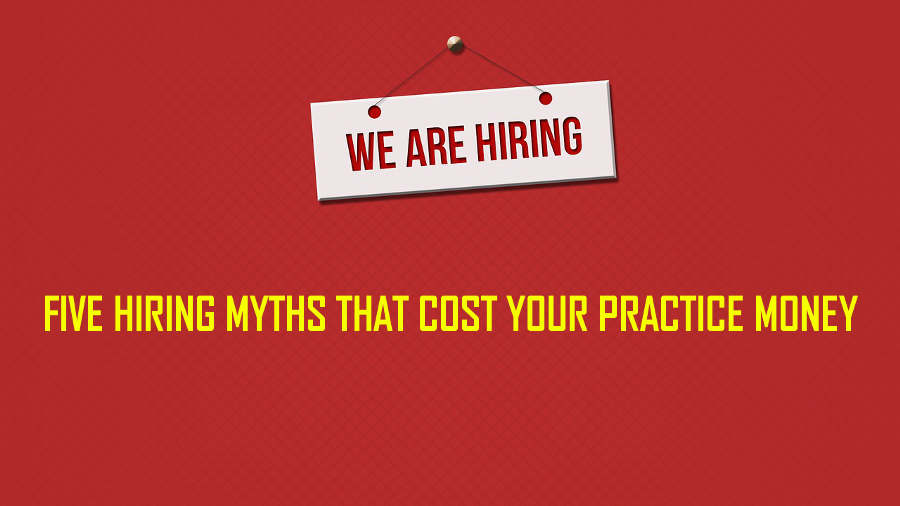
In this two part series, Jan van der Hoop and Tim Brennan of Fit First Technologies bust popular hiring myths to help you avoid making costly mistakes. Check back on March 21st for part two.
Myth #1: I need to hire people who have experience (usually at least 3-5 years) in this job.
The sad truth is that in the vast majority of cases, organizations find themselves hiring for experience and firing for job fit. We bring people in to the practice because they have the right blend of education, credentials, and work experience… and then we terminate them because they can’t get along well with their manager, their coworkers or your customers.
Far better to find people who fit. Candidates who can work productively with your people and your patients, and who have the ability to learn what they need to know quickly.
Myth #2: A solid résumé and a crisp, focused and well-written cover letter define the best candidate.
When you consider that most candidates don’t even write their own résumés, and factor in all the statistics around embellishment and outright falsification of information on résumés, it’s hard to believe that we are still accepting these documents as the primary admission ticket for candidates into any credible organization’s hiring pipeline.
When you layer on top of that the realization that there’s no correlation – none whatsoever – between what’s in the resume and how well people will perform or how long they will stay, you have to concede that relying on a resume to help you find the right candidate gives you about the same odds as buying a lottery ticket. The difference is that getting it wrong costs you a whole lot more that the buck you spent on the ticket.
Instead, screen first for the things that are predictors of retention and productivity – then look at their background.
Myth #3: Finding the right person is a numbers game. To improve my odds of finding the right person, I need to broadcast my opening using the big recruitment boards, the niche boards, and selected papers and publications.
The odds that candidates who post their resume online or who respond to an ad will be the right candidates for you to invest time in are pretty slim. At any given point, only about 20% of the workforce has an up-to-date resume… and they have and up to date resume because they are actively looking for work. When you think about it from that angle, these folks are typically are not the top performers you want to speak to.
There’s a huge difference between quantity of candidates and quality of candidates. The best quality candidates are usually not actively looking for work. They don’t hang out on the job boards or read the ads, and they don’t have an up-to-date resume. You want to target the 60% of the workforce who aren’t actively looking for work but who also aren’t in love with their current job.
Most of us don’t realize that requiring people to give you a resume is actually a barrier to
finding the right talent for our business. When you do away with that requirement, and set up a process where better people can apply without that inconvenience, you win.
Myth #4: First impressions are everything. A candidate needs to impress me in the first five minutes.
Yes, first impressions are important. And the statistics continue to show that most managers decide at an unconscious level whether or not they want to hire a candidate in the first three minutes or so of the interview. The other 57 minutes are basically a charade aimed at gathering information – positive or negative – to support whatever that decision was.
Really good managers are aware of that tendency… and they work to counteract it. One important way they do that is to be clear on the desired outcome… that they are looking for a top performer, not a top candidate. This difference is critical… top candidates have a great resume, show up on time and look the part, and so on… and these cosmetic factors we’ve been taught to value have no bearing at all on how long they will stay or how well they will work out. The list of attributes that are predictive of top performers is a completely different list.
Top performers share a very distinctive set of attributes and attitudes. They learn fast. They take responsibility. They build solid relationships. They think and act differently, and they fit differently in your business.
Myth #5: We need to offer top pay and top of the line benefits if we have a hope of attracting and keeping top performers.
Research and experience continue to show that pay and benefits are among the weakest ties. There’s no question you need to offer a package that’s in the right ballpark… but so long as these factors are roughly right, others become much more important.
The factors that attract the right candidates and keep your people focused and productive are what researchers refer to as the four critical aspects of fit. Fit with manager is the most important; it will make you or break you. The other three are fit with the job, with the team, and with the practice. It’s surprisingly easy to filter people in to a conversation with you on the basis of these aspects of fit, and yet remarkably few organizations have figured out how to do it reliably.

JAN G. VAN DER HOOP
Jan is the co-founder and president of Fit First Technologies, a company that applies its predictive analytics to the task of matching people to roles. Those algorithms drive platforms such as TalentSorter, FitFirstJobs and Eyeployment.com, which are relied upon by organizations to screen high volumes of candidates for “fit” in their open positions.

TIM BRENNAN
is Chief Visionary Officer with Fit First Technologies Inc, the creators of Eyeployment, TalentSorter and Jobtimize.







